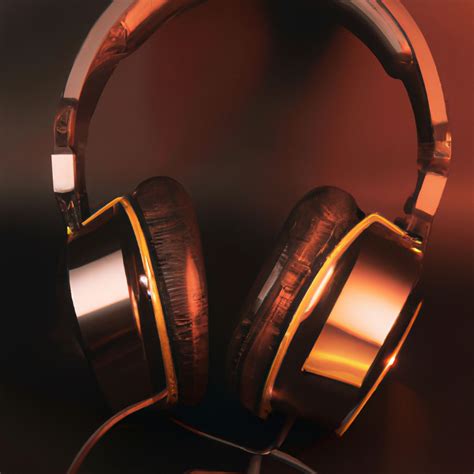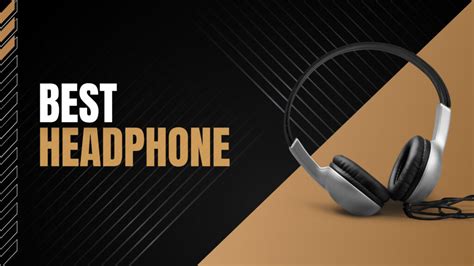Imagine immersing yourself in a world of rich sounds, where every note comes alive and every beat resonates with your soul. Headphones have become an essential companion for music lovers and audiophiles, allowing us to enjoy our favorite tracks without disturbing those around us. However, have you ever wondered why some headphones provide a superior listening experience, while others fall short of our expectations?
In the pursuit of the perfect sound, manufacturers employ various technologies and design choices to create headphones that cater to different preferences and budgets. But what factors contribute to the variation in performance between headphones? Is it the type of drivers used, the materials that make up the construction, or perhaps the way sound is transmitted to our eardrums?
One essential element to consider is the frequency response of headphones. This characteristic determines how accurately the headphones reproduce sound across the entire range of audible frequencies. While some headphones excel in delivering a balanced sound with equal emphasis on all frequencies, others may emphasize certain ranges, such as bass or treble, to create a more captivating listening experience.
The Influence of Sound Quality on Consumer Headphone Preferences

When it comes to selecting headphones, there are various factors that consumers take into account. One of the most critical aspects that strongly influences their choices is the audio quality offered by the headphones.
While consumers may have different preferences when it comes to sound quality, the impact it has on their overall listening experience cannot be overstated. Sound quality encompasses a range of elements, including clarity, accuracy, depth, and balance. It is the quality of these elements that contribute to the overall enjoyment and immersion while listening to music, podcasts, or any form of audio content.
When consumers are able to experience high-quality sound through their headphones, it allows them to fully appreciate the depth and nuances of the audio. On the other hand, poor sound quality can lead to distorted or muffled sound, which detracts from the overall listening experience.
Furthermore, the impact of audio quality extends beyond mere entertainment. For professionals such as musicians, sound engineers, and audiophiles, accurate and detailed audio reproduction is essential for their work. The ability to clearly discern individual instruments, vocals, or subtle nuances in sound can significantly affect their ability to create, edit, or appreciate music.
In today's market, headphone manufacturers are aware of the importance consumers place on sound quality. As a result, they invest in advanced technologies and sound engineering to create products that meet the demands of discerning listeners. This includes the use of high-quality drivers, effective noise isolation, and precise tuning to enhance audio reproduction.
Ultimately, the impact of audio quality on consumer headphone choices cannot be ignored. It is a defining factor that significantly influences consumer preferences and ultimately determines the overall satisfaction and enjoyment of their listening experience.
Exploring the Science behind Variances in Headphone Performance
In this section, we will delve into the scientific factors that contribute to the differences in the performance of various headphones, shedding light on the intricacies of their functionality. By examining the underlying principles and technical aspects of headphone design, we aim to understand the reasons behind the variations in audio quality, sound reproduction, and overall user experience.
Factors Affecting Sound Quality in Varied Headphone Models

Quality of sound produced by headphones can vary significantly from one model to another due to a multitude of factors. These factors influence audio fidelity and determine how accurately and faithfully the headphones reproduce the original audio signal.
Design and Build Quality: The structural design and build quality of headphones play a crucial role in audio fidelity. Factors such as the choice of materials, attention to detail in construction, and overall durability can impact sound reproduction. Higher quality materials and precise engineering can minimize vibrations, resonance, and distortions that may compromise audio performance.
Driver Technology: The type and quality of drivers used in headphones are key determinants of sound quality. Different driver technologies, such as dynamic, planar magnetic, or balanced armature, can affect factors like frequency response, distortion levels, and transient response. Additionally, the size, shape, and arrangement of drivers can influence the soundstage, imaging, and overall clarity.
Acoustic Engineering: Headphones designers employ various acoustic engineering techniques to optimize sound performance. Components like enclosures, baffles, and acoustic chambers can shape the sound signature, improve bass response, reduce resonances, and enhance overall clarity. The careful tuning and placement of these elements contribute to a balanced and accurate audio reproduction.
Electronics and Amplification: The internal electronics and amplification within headphones impact the signal processing and power delivery, ultimately affecting the sound quality. Factors like the quality of digital-to-analog converters (DACs), amplifiers, and crossover circuits can significantly influence the level of detail, precision, and dynamics in the audio reproduction. Additionally, the impedance and sensitivity of headphones can determine their compatibility with different audio sources and devices.
Personal Listening Preferences: Lastly, personal listening preferences can influence how one perceives the sound quality of headphones. Factors such as preferred music genres, desired tonal balance, and subjective perceptions of warmth or brightness can vary from person to person. As a result, what may sound better to one individual might not be the same for another.
Understanding these factors and their impact on audio fidelity can help individuals in selecting headphones that best suit their preferences and requirements. Manufacturers constantly innovate and refine their headphone designs, incorporating advancements in technology and materials to enhance the overall sound quality and provide a more immersive listening experience.
Understanding the Impact of Technology on Headphone Sound Quality
The quality of sound produced by headphones can vary significantly based on the underlying technological features and advancements employed in their design. This section aims to explore the role of technology in defining the sound quality of headphones, delving into the key factors that contribute to the overall listening experience.
- Driver Technology: One of the most crucial aspects influencing headphone sound quality is the driver technology used. Different types of drivers, such as dynamic, balanced armature, and planar magnetic drivers, offer distinct characteristics in terms of frequency response, soundstage, and overall clarity.
- Acoustic Design: The physical design and construction of headphones play a significant role in shaping sound quality. Factors like the shape of the ear cups, the material used for housing, and the presence of sound isolation mechanisms all contribute to the overall audio performance.
- Frequency Response: The frequency response range of headphones determines the extent to which different frequencies are accurately reproduced. A wide frequency response ensures a more balanced and immersive listening experience across various genres.
- Soundstage: The ability of headphones to reproduce a sense of space and positioning is known as the soundstage. Advanced technologies like virtual surround sound and binaural audio processing aim to enhance the perceived soundstage, creating a more realistic and engaging sound environment.
- Connectivity and Signal Processing: The advent of wireless and noise-canceling headphones has introduced new dimensions to sound quality. Bluetooth codecs, such as aptX and LDAC, enable high-quality wireless audio transmission, while advanced signal processing algorithms help in reducing background noise and improving audio clarity.
Understanding the intricate relationship between technology and sound performance is crucial for consumers looking to make informed choices when purchasing headphones. By considering the various technological aspects discussed in this section, individuals can select headphones that best align with their personal preferences and audio requirements.
Tips for Selecting Optimal Headphones Based on Performance Factors

When it comes to choosing the perfect pair of headphones, several performance factors should be taken into consideration. Understanding these key factors can help you make an informed decision and select headphones that meet your specific needs and preferences. This section provides useful tips and insights on how to choose the right headphones based on their performance characteristics.
| Performance Factor | Tips for Consideration |
|---|---|
| Sound Quality | Look for headphones that offer a wide frequency response, crisp high tones, well-defined midrange, and deep bass. Consider testing the headphones with various music genres to ensure overall audio performance meets your expectations. |
| Noise Cancellation | If you frequently find yourself in noisy environments or prefer immersive listening experiences, opt for headphones with active noise cancellation technology. This feature can significantly reduce external noise, allowing you to enjoy your music without distractions. |
| Comfort | Choose headphones with a comfortable design that fits well over your ears or inside your ear canals. Adjustable headbands, cushioned ear cups, and lightweight materials can enhance overall comfort, especially during prolonged listening sessions. |
| Wireless Connectivity | If you value freedom of movement, consider wireless headphones that utilize Bluetooth technology. Ensure the headphones have a stable connection, long battery life, and support the Bluetooth version compatible with your devices. |
| Durability | Check for headphones made from durable materials that can withstand regular usage and potential physical impacts. Look for reinforced cables, sturdy hinges, and reliable build quality to ensure your headphones last for a long time. |
| Portability | If you plan to use your headphones on-the-go, consider compact and foldable options that are easy to carry and store. Additionally, look for headphones with a protective case or pouch to prevent damage during transportation. |
By taking these performance factors into account and considering your personal preferences and requirements, you can select the best headphones that provide an exceptional audio experience tailored to your needs.
FAQ
Why do some headphones sound better than others?
There are several factors that contribute to the sound quality of headphones. These include the driver type, frequency response, impedance, and overall design and build quality. High-quality headphones generally use advanced drivers and have a wider frequency response, resulting in more accurate and detailed sound reproduction.
What is driver type and how does it affect headphone performance?
The driver type refers to the technology used to convert electrical signals into sound waves. Common driver types are dynamic, planar magnetic, and electrostatic. Each driver type has its own strengths and weaknesses, which can impact the sound quality. For example, planar magnetic drivers typically provide better bass response and soundstage compared to dynamic drivers.
Why is the frequency response important in headphones?
The frequency response indicates the range of frequencies that a headphone is capable of reproducing. A wider frequency response allows for better representation of different types of sound, which can result in more accurate audio reproduction. Headphones with a flat frequency response are generally preferred as they offer a balanced and natural sound.
What role does impedance play in headphone performance?
Impedance is a measure of the electrical resistance in headphones. It affects how efficiently the headphones can convert electrical signals into sound. Higher impedance headphones require more power to drive them, but they can also provide better control over the audio and prevent distortion. Matching the impedance of the headphones to the audio source can improve the overall performance.
Can the design and build quality of headphones affect their performance?
Yes, the design and build quality of headphones can significantly impact their performance. Factors such as the materials used, the construction techniques, and the comfort of the headphones can all influence the sound quality. High-quality headphones are designed to minimize resonance and vibrations, resulting in clearer audio reproduction and better overall performance.




